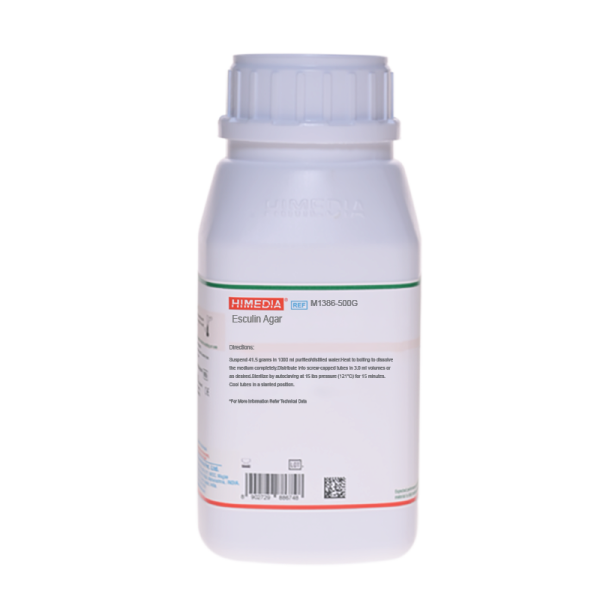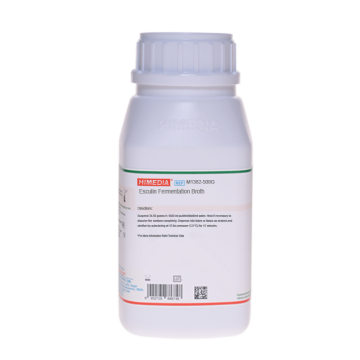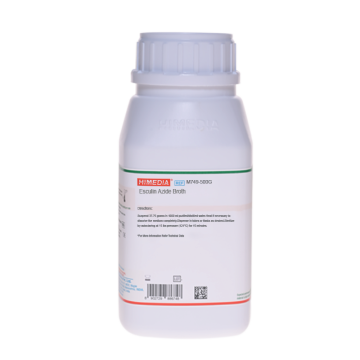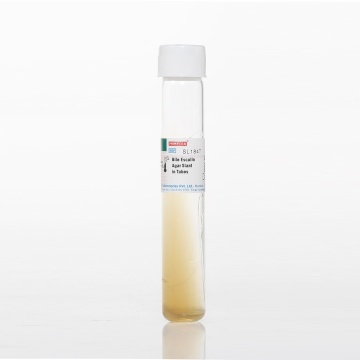 Your enquiry has been submitted
Your enquiry has been submitted
Esculin Agar
Intended Use
Recommended for cultivation and differentiation of bacteria that can hydrolyze esculin and produce H2S.
Composition**
| Ingredients | Gms / Litre |
|---|---|
| Tryptone | 13.000 |
| Sodium chloride | 5.000 |
| Yeast extract | 5.000 |
| HM infusion solids B # | 2.000 |
| Esculin | 1.000 |
| Ferric citrate | 0.500 |
| Agar | 15.000 |
Final pH (at 25°C): 7.3±0.2
**Formula adjusted, standardized to suit performance parameters # Equivalent to Beef heart infusion (solids)
Directions
Suspend 41.5 grams in 1000 ml purified / distilled water. Heat to boiling to dissolve the medium completely. Distribute into screw-capped tubes in 3 ml volumes or as desired. Sterilize by autoclaving at 15 lbs pressure (121°C) for 15 minutes. Cool tubes in a slanted position.
Principle And Interpretation
Esculin is a glycoside incorporated as a differential agent to facilitate the identification of various organisms, including Enterobacteriaceae, Enterococci and anaerobes.
Esculin Agar is based on the formula recommended (1), for the cultivation and differentiation of bacteria based on their ability to hydrolyze esculin and produce H2S. The unhydrolyzed esculin can be detected using long wave UV light at 360 nm since they will remain unchanged and fluorescence under UV light (4,5). Hydrolyzed esculin will not fluoresce and medium turns black (5).
Tryptone and HM infusion solids B provide amino acids and other nitrogenous substances that support bacterial growth. Esculin is a differentiating agent, which helps in identification of esculin-positive organism. Esculin is hydrolyzed to dextrose and esculetin, which forms a brown black complex in the presence of iron salt (ferric citrate) (4). Blackening of the agar medium.
Type of specimen
Isolated Microorganism
Specimen Collection and Handling
For samples follow appropriate techniques for handling specimens as per established guidelines (2,3). After use, contaminated materials must be sterilized by autoclaving before discarding.
Warning and Precautions
Read the label before opening the container. Wear protective gloves/protective clothing/eye protection/ face protection. Follow good microbiological lab practices while handling specimens and culture. Standard precautions as per established guidelines should be followed while handling specimens. Safety guidelines may be referred in individual safety data sheets.
Limitations
- Pure isolated colonies must be used for testing Esculin hydrolysis.
Performance and Evaluation
Performance of the medium is expected when used as per the direction on the label within the expiry period when stored at recommended temperature.
Quality Control
Appearance: Cream to yellow homogeneous free flowing powder
Gelling: Firm, comparable with 1.5% Agar gel
Colour and Clarity of prepared medium: Amber coloured, clear to slightly opalescent gel forms in tubes as slants
Reaction: Reation of 4.15% w/v aqueous solution at 25°C. pH: 7.3±0.2
pH: 7.10-7.50
Cultural Response
Cultural characteristics observed after an incubation at 35-37°C for 18-24 hours
| Organism | Inoculum (CFU) | Growth | Esculin hydrolysis |
|---|---|---|---|
| Escherichia coli ATCC 25922 (00013*) | 50-100 | good | negative reaction |
| Enterococcus faecalis ATCC 29212 (00087*) | 50-100 | luxuriant | positive reaction, blackening of medium |
| Streptococcus pyogenes ATCC 19615 | 50-100 | luxuriant | negative reaction |
Key: (*) Corresponding WDCM numbers.
Storage and Shelf Life
Store between 10-30°C in a tightly closed container and the prepared medium at 20-30°C. Use before expiry date on the label. On opening, product should be properly stored dry, after tightly capping the bottle in order to prevent lump formation due to the hygroscopic nature of the product. Improper storage of the product may lead to lump formation. Store in dry ventilated area protected from extremes of temperature and sources of ignition. Seal the container tightly after use. Product performance is best if used within stated expiry period.
Disposal
User must ensure safe disposal by autoclaving and/or incineration of used or unusable preparations of this product. Follow established laboratory procedures in disposing of infectious materials and material that comes into contact with sample must be decontaminated and disposed of in accordance with current laboratory techniques (2,3).
Reference
- Atlas R. M., 1996, Handbook of Microbiological Media, 2nd Ed., CRC Press
- Isenberg, H.D. Clinical Microbiology Procedures Handbook 2nd Edition.
- Jorgensen, J.H., Pfaller, M.A., Carroll, K.C., Funke, G., Landry, M.L., Richter, S.S and Warnock., D.W. (2015) Manual of Clinical Microbiology, 11th Edition. Vol. 1.
- Koneman E. W., Allen S. D., Janda W. M., Schreckenberger P. C., Winn W. C. Jr., 1997, Colour Atlas and Textbook of Diagnostic Microbiology, 5th Ed., J. B. Lippinccott- Raven Publishers, Philadelphia, Pa.
- Shigei, 1992, In Isenberg (Ed.), Clinical Microbiology Procedures Handbook, Vol. 1, American Society for Microbiology, Washington, D.C.
| Product Name | Esculin Agar |
|---|---|
| SKU | M1386 |
| Product Type | Regular |
| Physical Form | Powder |
| Origin | Animal |
| Packaging type | HDPE |
| References | 1. Atlas R. M., 1996, Handbook of Microbiological Media, 2nd Ed., CRC Press, |
| Customized Product Available | No |











